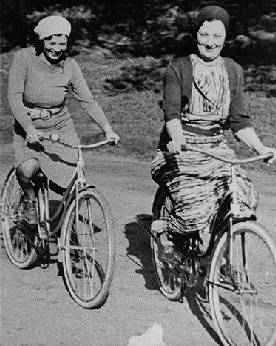Women & Bicycles
Cycling in Golden Gate Park c. 1930s.
In the early 1890s, a few fashionable women in San Francisco began to shorten their skirts a few inches to accommodate their latest pastime: bicycling. By 1895, so many women in the United States were bicycling that they started a new movement for dress reform (trading long skirts and petticoats for shorter outfits, bloomers, and gaiters). But more important than the new freedom of dress was the new freedom of movement.
As Mrs. Reginald de Koven wrote for Cosmopolitan magazine in August, 1885, "To men, rich and poor, the bicycle is an unmixed blessing, but to women it is deliverance, revolution, salvation. It is well nigh impossible to overestimate the potentialities of this exercise in the curing of the common and characteristic ills of womankind, both physical and mental, or to calculate the far reaching effects of its influence in the matters of dress and social reform ."
The bicycle was seen as a cure for women who suffered from the cultural diseases of the era--hysteria, vapors, and nerves--that were brought on by stiflingly tight corsets and social manners.
"The rewards which this exercise offers are so great, in the fascination of the free motion, the exhilaration of the sense of power over the wheel, the delight of flying through the landscape," Mrs. de Koven went on, "that it is no wonder it is potent to bring delicate, fanciful women off their couches, and to rid them of vapors and nerves."
Even more amazing bicycle-cures seemed to be possible: "The bicycle actually has been used by physicians as a means of curing insanity, and there is an authenticated case of an inmate of a retreat in Brooklyn who was restored to sanity by the use of the machine; surely an astonishing proof of what this regular absorbing physically healthful exercise may do for a mind diseased.
—Laura Fraser

